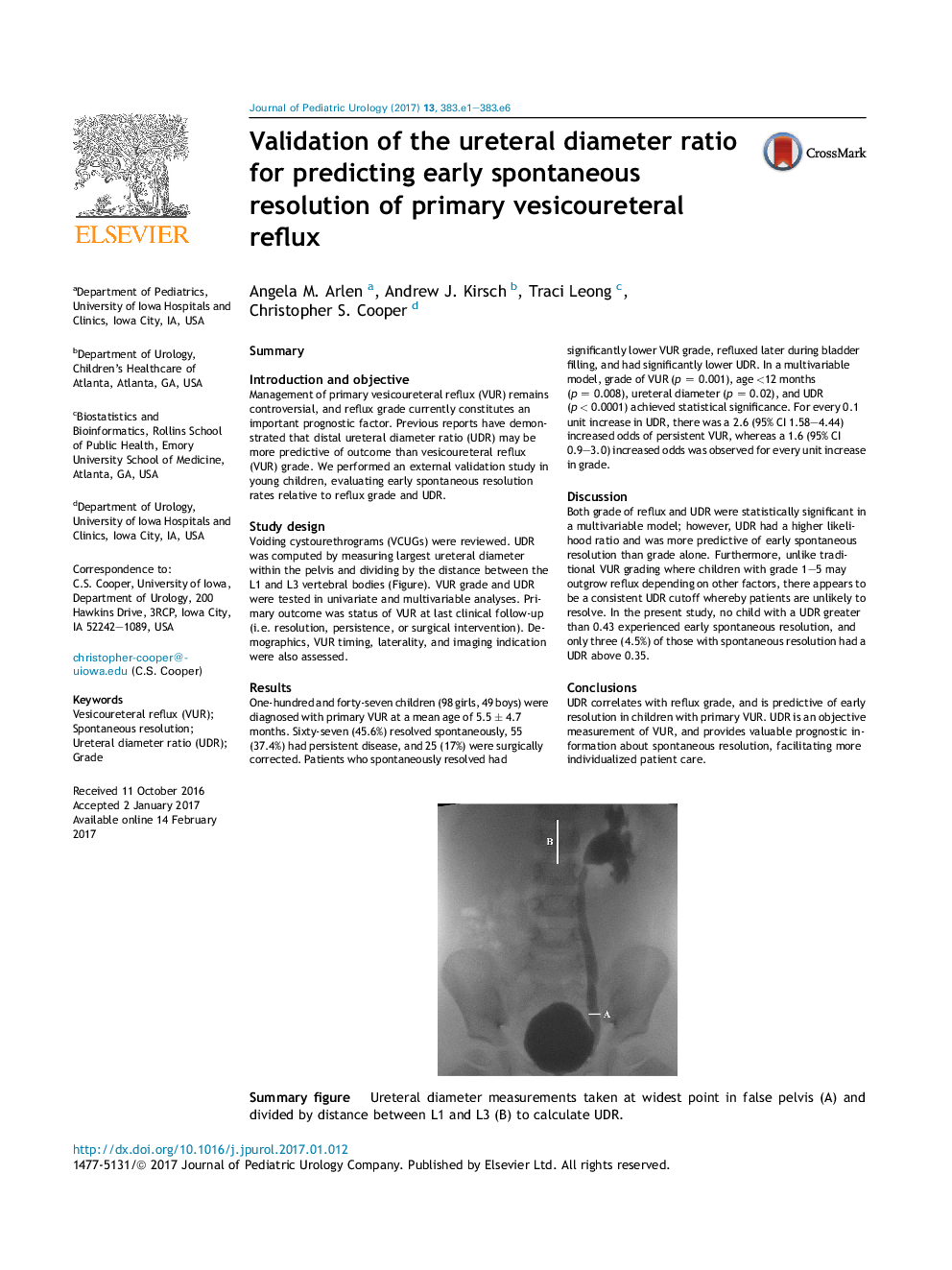| کد مقاله | کد نشریه | سال انتشار | مقاله انگلیسی | نسخه تمام متن |
|---|---|---|---|---|
| 5718551 | 1607135 | 2017 | 6 صفحه PDF | دانلود رایگان |
SummaryIntroduction and objectiveManagement of primary vesicoureteral reflux (VUR) remains controversial, and reflux grade currently constitutes an important prognostic factor. Previous reports have demonstrated that distal ureteral diameter ratio (UDR) may be more predictive of outcome than vesicoureteral reflux (VUR) grade. We performed an external validation study in young children, evaluating early spontaneous resolution rates relative to reflux grade and UDR.Study designVoiding cystourethrograms (VCUGs) were reviewed. UDR was computed by measuring largest ureteral diameter within the pelvis and dividing by the distance between the L1 and L3 vertebral bodies (Figure). VUR grade and UDR were tested in univariate and multivariable analyses. Primary outcome was status of VUR at last clinical follow-up (i.e. resolution, persistence, or surgical intervention). Demographics, VUR timing, laterality, and imaging indication were also assessed.ResultsOne-hundred and forty-seven children (98 girls, 49 boys) were diagnosed with primary VUR at a mean age of 5.5 ± 4.7 months. Sixty-seven (45.6%) resolved spontaneously, 55 (37.4%) had persistent disease, and 25 (17%) were surgically corrected. Patients who spontaneously resolved had significantly lower VUR grade, refluxed later during bladder filling, and had significantly lower UDR. In a multivariable model, grade of VUR (p = 0.001), age <12 months (p = 0.008), ureteral diameter (p = 0.02), and UDR (p < 0.0001) achieved statistical significance. For every 0.1 unit increase in UDR, there was a 2.6 (95% CI 1.58-4.44) increased odds of persistent VUR, whereas a 1.6 (95% CI 0.9-3.0) increased odds was observed for every unit increase in grade.DiscussionBoth grade of reflux and UDR were statistically significant in a multivariable model; however, UDR had a higher likelihood ratio and was more predictive of early spontaneous resolution than grade alone. Furthermore, unlike traditional VUR grading where children with grade 1-5 may outgrow reflux depending on other factors, there appears to be a consistent UDR cutoff whereby patients are unlikely to resolve. In the present study, no child with a UDR greater than 0.43 experienced early spontaneous resolution, and only three (4.5%) of those with spontaneous resolution had a UDR above 0.35.ConclusionsUDR correlates with reflux grade, and is predictive of early resolution in children with primary VUR. UDR is an objective measurement of VUR, and provides valuable prognostic information about spontaneous resolution, facilitating more individualized patient care.88Summary figure. Ureteral diameter measurements taken at widest point in false pelvis (A) and divided by distance between L1 and L3 (B) to calculate UDR.
Journal: Journal of Pediatric Urology - Volume 13, Issue 4, August 2017, Pages 383.e1-383.e6
